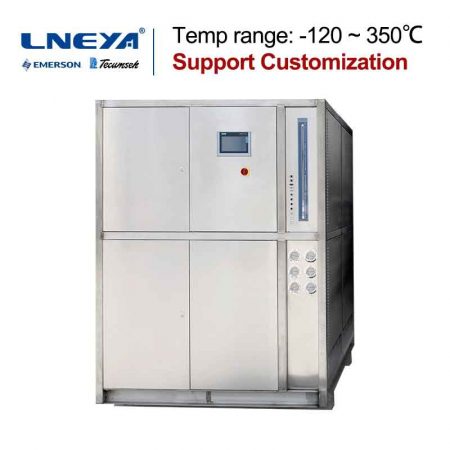Chemical Reactor Temperature Control
Kontaktieren Sie uns noch heute für die perfekte Lösung zur Temperaturkontrolle
With the continuous development of society, industrial production requirements are becoming higher and higher, and the temperature control requirements for reactors are becoming more and more stringent. As an important temperature control equipment, chemical reactor temperature control system has gradually become an essential product for chemical companies.
The chemical reactor temperature control system uses a variety of control technologies to control the internal temperature of the reactor. This kind of system can monitor the temperature changes inside the reactor in real time through a temperature sensor, and then perform feedback control through the controller to keep the temperature inside the reactor within a stable range. This kind of system can not only improve the accuracy and efficiency of chemical production, but also greatly reduce human errors in the production process and improve work safety.
The chemical reactor temperature control system has many advantages. First, it can greatly improve production efficiency. During the production process of the reactor, maintaining a constant temperature is crucial to the success of the reaction. The chemical reactor temperature control system can automatically control the temperature to make the reaction process more efficient. Secondly, it can reduce production costs. The use of reactor temperature control systems can reduce human errors in the production process, thereby reducing waste generation, improving product quality, and saving production costs.

The components of chemical reactor temperature control system are:
1. Temperature control system: Built-in temperature sensor and controller for monitoring and maintaining the set temperature value. Temperature control can be achieved and has stability and reliability.
2. Heating and cooling system: It has heating and cooling functions and can provide high or low temperature environment as needed. Heating systems use electric heating rods or heating elements to generate heat energy, while refrigeration systems use compressors and refrigerants to perform the cooling process.
3. Circulation system: The temperature control medium (usually water or oil) is sent to the target equipment or container through a circulation pump. The circulation system ensures even temperature distribution and provides fast temperature response.
4. Safety protection system: Equipment is usually equipped with safety devices such as overheating protection, overload protection, and leakage protection to ensure the safe operation of the equipment.
Advantages of chemical reactor temperature control system:
1. Precise control: It can achieve precise control of the target temperature and has high temperature stability and accuracy.
2. Wide application: It can meet the temperature requirements of various fields, such as material testing, biological experiments, medical testing, etc.
3. Energy saving: Equipped with heating and cooling systems, as well as a circulation system, it can quickly reach the set temperature and maintain it constant, while saving energy consumption.
4. Safe and reliable: The equipment has a variety of built-in safety protection mechanisms to ensure that the equipment operates safely and reliably, and has the ability to operate continuously for a long time.
E-Mail: info@lneya.com WeChat ID: +8615251628237 WhatsApp: +86 17851209193
 Präzisionskältemaschinen / Kleinkältemaschinen
Präzisionskältemaschinen / Kleinkältemaschinen
Die Kältemaschine kann in verschiedenen Industrien und Labors eingesetzt werden und unterstützt kundenspezifische Designs.
| Temperaturbereich | -18°C ~ +30°C | +5°C ~ +35°C Reihe |
| Kühlleistung | 0,35 ~ 0,9kW | 1,8 ~ 50kW |

Rückkühler
Unser Rückkühler arbeitet mit Niedertemperatur-Kältetechnik, die Temperatur beträgt bis zu -120℃, und verschiedene Zubehörteile sind anpassbar.
| Temperaturbereich | Serie -25°C ~ +30°C | -45°C ~ +30°C Reihe | Serie -60°C ~ -20°C | Serie -80°C ~ -20°C | Serie -120°C ~ -70°C |
| Kühlleistung | 0,8 ~ 30kW | 0,75 ~ 12kW | 0,4 ~ 6kW | 0,2 ~ 6kW | 0,3 ~ 5kW |

Niedertemperatur-Kühlgeräte
Wir haben uns auf die Herstellung von Niedertemperaturkältemaschinen mit einem Temperaturregelbereich von bis zu -150°C spezialisiert, die den Kühlbedarf verschiedener Branchen decken.
| Temperaturbereich | Serie -25°C ~ -5°C | Serie -45°C ~ -10°C | Serie -60°C ~ -10°C | Serie -80°C ~ -30°C | Serie -110°C ~ -50°C | Serie -150°C ~ -110°C |
| Kühlleistung | 12 ~ 360kW | 6 ~ 180kW | 6 ~ 180kW | 4 ~ 180kW | 2 ~ 120kW | 2,5 ~ 11kW |
Temperatursimulation für die Qualitätsprüfung von Fahrzeugen: Prüfung der Batterielebensdauer, Prüfstand für Einspritzdüsen/Motoren, Airbag-Prüfung, Komponentenprüfstand, usw.

Geeignet für die präzise Temperaturkontrolle von elektronischen Bauteilen. Bei der Herstellung von elektronischen Halbleiterkomponenten für raue Umgebungen umfassen die Phasen der IC-Gehäusemontage sowie der Entwicklungs- und Produktionstests auch elektronische Wärmetests und andere Simulationen von Umwelttests.

Flüssigkeitskühlung für Batterie-Energiespeichersysteme
| Typen | Für Converting Station | Für Energiespeicherbatterie | Für die Ladestation |
| Kühlleistung | 45kW | 5 ~ 8,5kW | 4kW |

Baureihe ZLFQ
Kühlmittelverteilereinheit
Flüssigkeitskühlgeräte eignen sich für die Prüfung von Halbleitern, die Prüfung elektronischer Geräte bei konstanter Temperatur, die Kühlung der Serverinfrastruktur und andere Orte, an denen die Temperatur von Flüssigkeiten kontrolliert wird.
| Temperaturbereich | +5°C ~ +35°C | +5°C ~ +35°C |
| Kühlleistung | 15 ~ 150kW | 200 ~ 500kW |

MD-Thermofutter-Serie
Es wird für die Prüfung von HF-Bauteilen und Leistungsbauteilen mit hoher Dichte (IGBTs und MOSFETs) verwendet und kann auch für die schnelle Kühlung von flachen Laborplatten (Plasma, biologische Produkte, Batterien) usw. eingesetzt werden.
| Temperaturbereich | -75°C ~ +225°C |
| Temperaturgenauigkeit | ±0.1℃ |

Schraubenkühler (Benutzerdefinierte Designs)
Niedertemperatur-Schraubenkühlmaschinen und Raumtemperatur-Schraubenkühlmaschinen
| Temperaturbereich | +5°C ~ +30°C | +5°C ~ +30°C | +5°C ~ +30°C | +5°C ~ +30°C | -25°C ~ +5°C | -25°C ~ +5°C |
| Kühlleistung | 107 ~ 1027kW (Einzelverdichter) | 299 ~ 2134kW (Doppelkompressor) | 98 ~ 934kW (Einzelverdichter) | 272 ~ 1940kW (Doppelkompressor) | 48 ~ 467kW (Einzelverdichter) | 51 ~ 497kW (Einzelverdichter) |
 LNEYA
LNEYA
 简体中文
简体中文



















































































